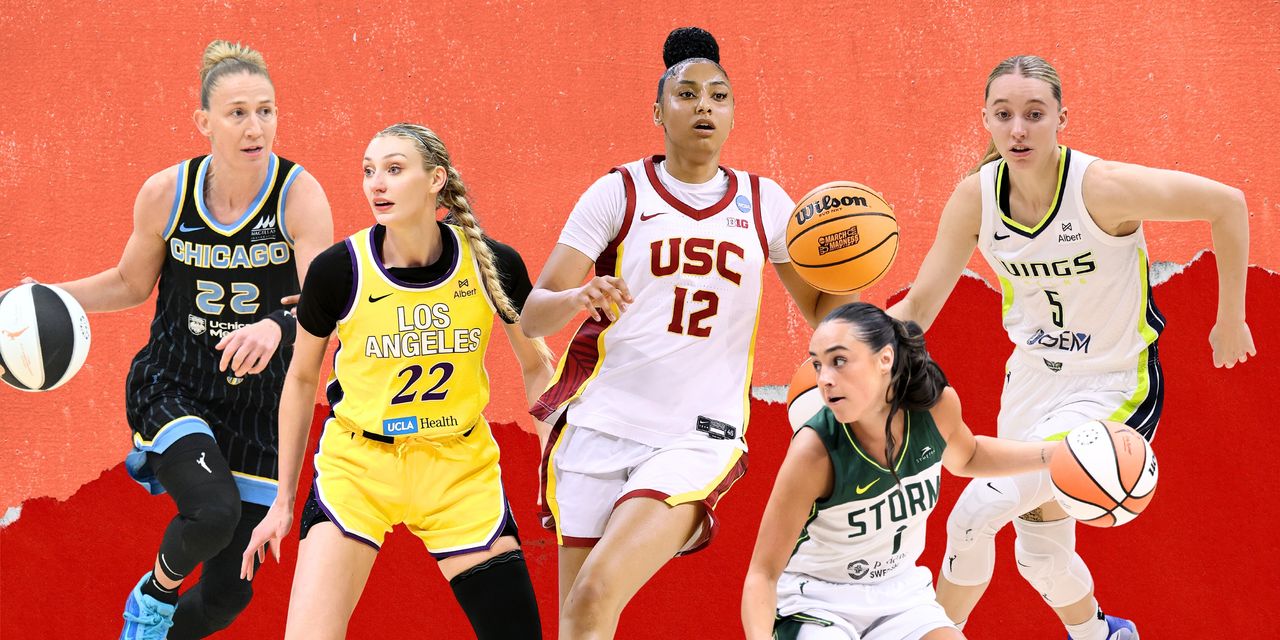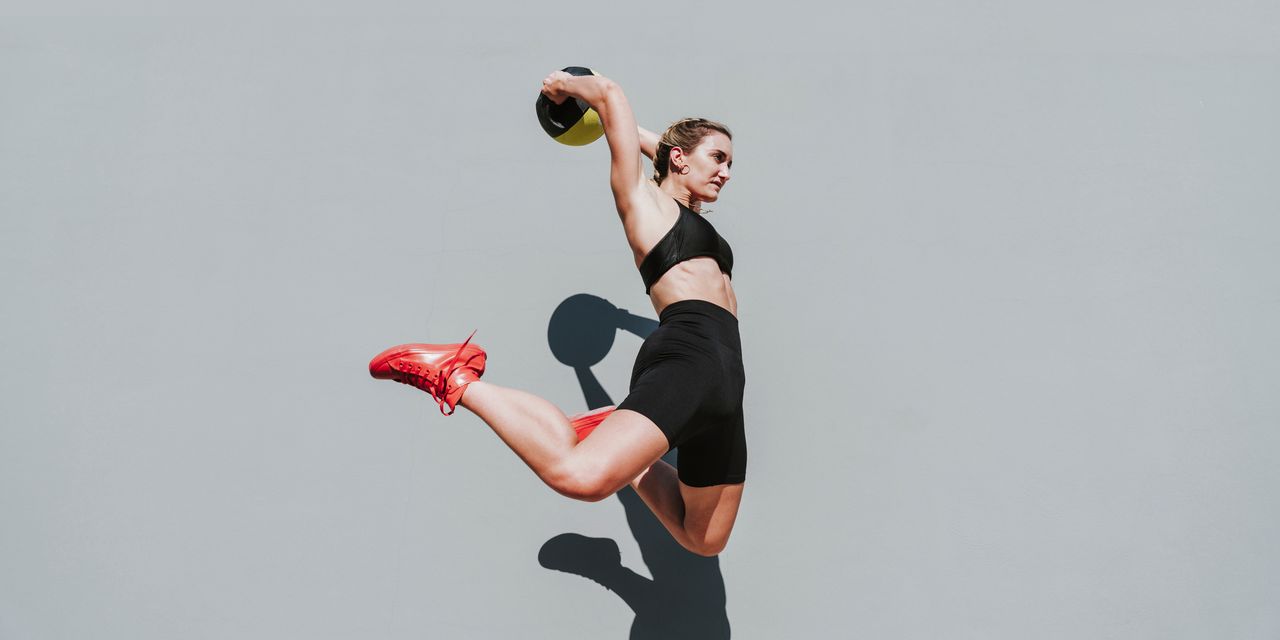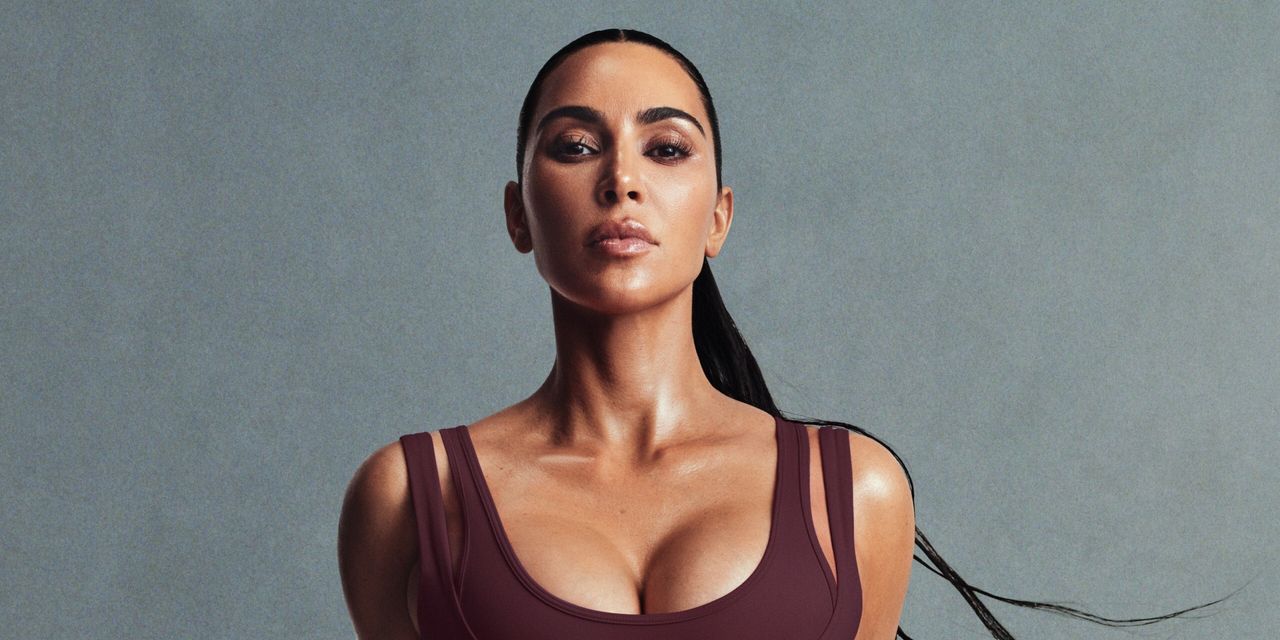Why Are So Many Women Athletes Tearing Their ACLs Now?

On June 7, Chicago Sky veteran Courtney Vandersloot was driving to the basket, hoping to score against the Indiana Fever. But before she could take a shot, she fell to the ground, crying out in pain and clutching her right knee. An MRI later revealed that she was the latest in a long list of WNBA players to sustain one of the sport’s most dreaded injuries: a torn anterior cruciate ligament, or ACL.
If you feel like you hear about a new WNBA or college player sidelined by an ACL tear every day, you’re not imagining things. Cameron Brink—who just returned to the court after 13 months—as well as Nika Muhl, Paige Bueckers, and JuJu Watkins all got the same diagnosis in the past several years. And that’s not even mentioning the multiple players in the National Women’s Soccer League and the US Women’s National Team who have torn their ACLs recently, too—or the beach volleyball players in your local pickup game.
Researchers have long known that women are far more likely to tear their ACLs. While precise estimates vary depending on the age group and population, they likely have about three to four times the risk as men, Holly Silvers-Granelli, PhD, PT, owner of Velocity Physical Therapy in Los Angeles and chair of Major League Soccer’s Medical Assessment Research Committee, tells SELF.
Now that women have more opportunities than ever to play high-level sports, they’re exposed to more risk. “The overall rate has not changed that much,” Dr. Silvers-Granelli says, “but women are playing much longer and at a higher level than we ever had before in history.” And because female athletes are now—rightfully!—a lot more high-profile, we’re also more likely to hear about it when they do get such an injury, Amy West, MD, a sports medicine physiatrist at Northwell Health, tells SELF.
None of this means that women are delicate or doomed to get hurt, but that sometimes the system’s stacked against them. Fortunately, as scientists increasingly understand the risk factors that raise the danger for women—including biomechanical differences, hormones, and unequal access to resources—they know that many can be changed and others mitigated.
What’s more, some of the most scientifically solid prevention programs are free and available to everyone, from a WNBA forward to a rec league goalie. Here’s more about how these injuries happen, the factors that change the game for women, and what to do about it all.
What is an ACL tear, anyway, and how does it happen?
Your knee has four major ligaments that connect your femur (thigh bone) to your tibia (shin bone), keeping the joint stable. Two collateral ligaments run along the outside, while the two cruciate ligaments—including the ACL in front and the posterior cruciate ligament, or PCL, in back—crisscross diagonally to hold things together from the inside of the joint.
Your ACL’s role is to stabilize the knee’s front and back motion, preventing your tibia from sliding out ahead of your femur. It also gives you control over rotation—“the ability to step with your foot and then turn and feel like, ‘Hey, I have good support below me in order to move explosively,’” Gabriella Ode, MD, sports medicine surgeon at Hospital for Special Surgery, member of the Women’s Sports Medicine Center, and team physician for the New York Liberty, tells SELF.
That makes the ACL crucial in sports that involve cutting and pivoting, like basketball and soccer, Natasha Trentacosta, MD, a Cedars-Sinai orthopedic surgeon who specializes in pediatric and adult sports medicine, tells SELF. It’s also why players in these sports are at particular risk. Because while you can tear your ACL during a contact injury—for example, when someone slams into your knee from the side—that’s often not the way it happens, especially for women.
More likely is that you’re running and change directions or stop quickly, and your knee either buckles inward or hyperextends. Or you may land awkwardly from a jump, putting strain on your ACL. “That ligament, which is supposed to be tight and taut, stretches beyond what its natural elasticity is,” Dr. Ode says. “And once it stretches past that limit, it’ll rupture.”
In other cases, “even after studying videos, it’s hard to see why it happens,” Dr. West says, which can make it confusing for athletes or even someone watching. Vandersloot, for instance, didn’t make contact with anyone or even seem to pivot before she went down.
What does tearing your ACL feel like, and how is it treated?
The symptoms depend somewhat on the circumstances of the tear and also on whether you injured other surrounding tissues, such as the collateral ligaments or the meniscus, the cartilage that provides cushioning between your tibia and femur, Dr. Silvers-Granelli says.
Many people actually hear a snap or a pop, which can be jarring. For some, that’s followed by instant pain and the inability to put any weight on their leg. Others can stand and even try to jog, run, or play for a few more minutes. But afterward, most people have swelling and discomfort on the front or side of the knee.
Dr. Ode knows these signs from experience: During her sports medicine residency, she tore her ACL in a recreational soccer game. She felt the telltale pop and a sharp pain, which subsided, giving way to difficulty walking. Even though she had a strong suspicion of what happened, she couldn’t help but cry a little when another doctor confirmed it.
That’s another effect of ACL tears that can’t be understated: The mental impact can be huge. “This is an injury that typically occurs in athletic people who are participating in a sport or doing some sort of high-level activity, and it really derails their mobility and their desires for sport and activity, whether short- or long-term,” Dr. Ode says. “It’s totally okay to have an emotional response.”
Those feelings can well up because athletes realize they have a long journey ahead. Most people with ACL tears—including essentially all young athletes—need surgery, which reconstructs the ligament, usually using tendons from another part of the patient’s own leg. All in all, between prehab, surgery, recovery, and rehab, the process can take nine to 12 months (or longer!) before returning to sports, Dr. Ode says.
Then, there’s what comes after—sometimes well after. While Dr. Ode was able to safely get back to running, strength training, and soccer, she developed mild arthritis in her knee 12 years later. And that’s something that eventually occurs in nearly nine of 10 people who tear their ACL.
“Arthritis is one of the leading causes of disability and affects quality of life among Americans,” she says. “If we have a large population of women, particularly athletic women, who we see coming down the pipeline after ACL injuries presenting with early arthritis, we know that’s a problem that we need to address early and often to help minimize that risk.” That’s why research on the underlying risk factors and causes—and what can be done to mitigate them—is essential.
So why are women at greater risk of ACL tears?
Experts are still working hard to nail down the details, but it’s been difficult to dig into since most research focuses mainly on male athletes. In fact, one analysis published in the Women in Sport and Physical Activity Journal in 2021 found just 6% of exercise science studies focused solely on female athletes.
In contrast to this trend, Dr. Silvers-Granelli began researching ACL tears specifically in women two decades ago, and many others have since joined her. Their work has pinpointed several likely contributing factors:
Biomechanics
While there are some differences in the way women’s bodies are built—more on that in a moment—what seems to matter far more is how those bodies move. And that’s good news, since movement patterns are changeable.
“One huge thing is neuromuscular control,” Dr. Trentacosta says. “Men, they land from a jump, they tend to bend into the jump, bending their knees and then their hips. We tend to do it with a stiffer leg, so it puts more pressure on that knee.” When women cut or pivot, their knees more often move inward into a knock-kneed position, which also strains the ACL.
Women also tend to play more upright than men, which can pose problems, especially when they decelerate. A lower stance better engages the glutes and hamstrings, which serve as reins to pull the shins back and prevent the knee from hyperextending, Dr. Silvers-Granelli says. Women’s quads also tend to be stronger than their glutes and hamstrings, further hampering that natural braking system.
Now, none of this happens because women have naturally poor form or weak muscles. Rather, it likely has a lot more to do with the way girls and women are trained, or not, in areas like strength, technique, and agility. Until relatively recently, young female athletes typically weren’t given the same instruction in biomechanics (which could help them land and pivot more safely) or encouraged to hit the weight room, which could help strengthen those important muscles, Dr. West says.
One way researchers know this is that when they studied the biomechanics of dancers—who are trained how to jump properly from a young age—they found no sex differences in how they landed.
Access to resources
Another cause that can be modified: the level of assistance available to both prevent and treat injuries. As women’s sports continues its rise, some teams are now well supported: The Liberty, for example, has a medical performance team that includes athletic trainers, physical therapists, physicians, dietitians, and other experts who deliver individualized assistance from the start of the season and going into the off-season, Dr. Ode says.
But that hasn’t been the case historically, and still isn’t true across the board. Compared to their equivalents on the men’s side, women’s squads and leagues at every level are often at a disadvantage when it comes to everything from appropriate gear to playing surface to access to medical resources and coaches who will implement prevention programs and training—disparities that could increase the danger, Dr. Silvers-Granelli says.
Hormones
Fun fact: Women’s monthly hormonal fluctuations are one reason why women (and even female mice) haven’t always been included in medical or exercise science research. Menstrual cycles might confound the results, researchers worried—never mind that the approximately half of the population who have them might be interested in how the shifts influence their health.
Indeed, it turns out those ebbs and flows may make a difference in susceptibility to tendon injuries. Unlike men, women’s ACLs have relaxin receptors, a hormone that’s released at high levels just after ovulation and breaks down collagen, loosening ligaments.
That’s likely a good thing during pregnancy, but less useful during quick pivots on the court or pitch. And hormones also influence how women feel and recover, potentially leading to excess fatigue at some points that can add to injury risk, Dr. Ode says.
To explore this issue, Dr. Trentacosta and her colleagues compared injury rates between 32 athletes taking hormonal contraceptives—which modulate those monthly shifts and prevent ovulation, keeping relaxin levels low—and 40 who weren’t. Those who were on birth control had fewer ACL tears and other injuries, and also different biomechanics when landing from a jump.
This doesn’t mean athletes should take the pill to prevent ACL tears, Dr. Trentacosta says (although it’s one factor they might consider if they’re deciding between contraceptive methods). But it does confirm a correlation between hormones and risk that deserves further exploration.
Genetics
Like many other medical problems, ACL tears can run in families, and some of the genes linked to a higher risk may have a bigger impact on women than men. In fact, one 2020 study in the British Journal of Sports Medicine estimated that about 69% of the risk is heritable, meaning that if you looked at a group of athletes, about 69% of the difference in the rate of ACL tears between them would be due to genetics rather than environmental factors.
Anatomy
On average, women have shorter femurs in relation to the width of their hips. That means their Q angle—the angle formed between the quadriceps and kneecap, when viewed from the front—is wider, placing more stress across the knee joint, Dr. Ode says. Plus, the notch where the ACL sits tends to be a bit more narrow in women than men, potentially increasing the risk for tearing.
But even football players with dramatically different bodies from female soccer players, including larger notches, still tear their ACLs, as do people with no family history of such injuries. And no athlete can fundamentally alter their anatomy, or their genes, anyway. So rather than dwelling on these differences and instilling fear—which, paradoxically, actually further increases the risk of injury—it makes a lot more sense to focus on prevention methods that are known to work, Dr. Silvers-Granelli says.
So what can women do to protect themselves?
If there’s one message women’s sports medicine experts have for athletes, it’s that their bodies aren’t fragile and injuries aren’t inevitable. Everything from proper nutrition and recovery to specific prevention programs can go a long way toward mitigating the risk of ACL tears and other injuries. Here are some other prevention strategies to keep in mind:
1. Follow the program.
Pinpointing the neuromuscular and biomechanical risk factors that increase the risk of ACL tears has allowed researchers like Dr. Silvers-Granelli to develop exercise programs specifically to address them. Most are 10- to 15-minute sessions involving elements like running drills, plyometrics, strength moves, and stretching, which can double as a dynamic warm-up. Not only do they strengthen muscles and improve mobility, they also increase body awareness and proprioception, or the sense of where your body is in space, which is important for pivoting and landing, Dr. Ode says.
They’re shockingly effective: In a 2005 study, one of those programs—Prevent Injury and Enhance Performance Program, or PEP—decreased ACL injuries among 14- to 18-year-old female soccer players by 88% over two years. Female players in college who did a similar program, the FIFA 11+, cut their risk of any type of leg injury by 83% by the third season. “A four in five chance that I can mitigate my risk is one I would take,” Dr. Silvers-Granelli says, noting they’re freely available and anyone can do them.
2. Hit the weight room.
In addition, strengthening your hamstrings, quads, and glutes can fortify your knees and improve your biomechanics, Dr. Ode says. Exercises with a mini band that work the sides of the hips can stabilize the pelvis and prevent the knee from collapsing inward, Dr. Silvers-Granelli says. And Dr. Trentacosta often recommends Pilates to her athletes, for its focus on the core and glutes.
3. Vary your training.
For athletes of any age, cross-training can prevent you from overstressing the same set of muscles and tendons, as well as get you moving in different planes so you’re a more well-rounded athlete. “Especially for younger athletes, don’t play the same thing all day, every day, four seasons in a row,” Dr. West says. “You need to diversify how you’re moving.”
4. Heed your hormones.
There’s not really solid evidence to support cycle-syncing your workouts—for one thing, not everyone experiences the same effects throughout the month—but it makes sense to note how you typically feel at various points in your cycle and factor that into your workout plans. “Certainly for women who say they’re on their period or at certain phases in their cycle, they may notice that they have more general fatigue or muscle aches,” Dr. Ode says. At those times, consider prioritizing recovery, prevention exercises, and other steps that can reduce your risk of injury.
5. Eat well and recover.
Sleeping well, incorporating plenty of rest into your training, and eating a nutritious diet give your body the time and building blocks it needs to recover from the hard work you do in the gym and outside of it, Dr. West says. And fueling your body appropriately can reduce your risk of injury overall.
Even with all this knowledge, there’s still a lot to be done to make women’s sports safer.
One big barrier has been convincing coaches to implement ACL prevention programs. Dr. Silvers-Granelli and others continue to promote them, hoping to persuade everyone from NWSL and WNBA coaches to youth leagues to incorporate them.
While exercise scientists have made progress in understanding risks and developing prevention strategies to protect women athletes from ACL tears, there’s still a lot left to be uncovered. And scientists are eager to dive in and learn more to support the women’s sports superstars lighting up the court and the pitch.
Dr. West, for example, is currently analyzing data from female collegiate athletes’ Whoop trackers to study the relationships between factors like sleep, menstrual cycles, mental health, and injury risk. Dr. Trentacosta and her colleagues are hoping to expand the study of hormonal contraceptives to include athletes across the country and in professional leagues, such as the NWSL and WNBA.
But there are some snags. A big one? Some of this type of work has been threatened by shifts in the current presidential administration’s research funding priorities. According to the website Unbreaking, the National Institutes of Health—previously the largest public funder of medical research in the world—has canceled or frozen more than 2,600 grants this year, or nearly $2.2 billion in awards as of late July. Many of these were tied to diversity, equity, and inclusion, or flagged because they included words like “women” and “gender.”
Although many of these cancellations have been challenged in court, some successfully, scientists have already seen the fallout; Dr. Silvers-Granelli, for instance, says she recently lost funding for two grants. While she and her collaborators were able to find secure philanthropic funding to complete the study, the pattern of pulling back support for academic medical research concerns her. “One of the things that has made the US so prolific in terms of research and medical advances is our university system,” she says. “To see that be curtailed is very troublesome.”
Where she sees hope is in the energy and investment pouring into women’s sports. The NWSL is currently trying to establish an equivalent organization to Major League Soccer’s research arm, for instance. And team owners are doing more than buying franchises; they’re also sinking money into governing bodies and other sources of infrastructure. For example, Washington Spirit owner Michele Kang gave a $30 million gift to US Soccer last fall, earmarked for girls’ and women’s programs.
It makes sense, Dr. Silvers-Granelli says: “People are spending meaningful money to acquire these franchises—you want to keep your players healthy,” she says. “It’s somewhat self-serving, but then it has the benevolence to the player, too, so it can be a win-win.”
No matter where the money comes from, there’s nothing exclusionary about research focusing on female athletes, Dr. Ode says—without it, players like Vandersloot and Brink, and their support teams, have incomplete and inaccurate information.
“Fields like women’s sports medicine and initiatives that look at sex-based differences are critical, because they are helping us understand care for half the population,” Dr. Ode says. “It’s not being exclusive to the other half, but it’s trying to understand where we have fallen behind because that half was not getting half of the research over the last 50-plus years. The research and innovation were inequitable, so we’re just trying to level the playing field.”
Related:
- How to Return to Exercise After Being Sidelined With an Injury
- 8 Workout Pains You Should Never Ignore
- Why Am I Already Dealing With Knee Pain in My 30s?
Get more of SELF’s great fitness coverage delivered right to your inbox—for free.




